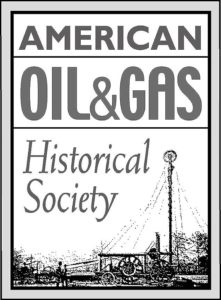by Bruce Wells | Dec 9, 2024 | This Week in Petroleum History
December 9, 1921 – Scientists discover Anti-Knock Properties of Leaded Gas –
Working for General Motors, scientists Thomas Midgely Jr. and Charles Kettering discovered the antiknock properties of tetraethyl lead. They had spent years examining properties of knock suppressors such as bromine and iodine, but when tetraethyl lead (diluted to a ratio of one part per thousand) was added to the gasoline of a one-cylinder engine, the knocking abruptly disappeared.
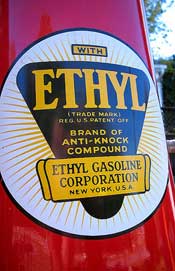
Public health concerns would lead to phase-out of tetraethyl lead in gasoline.
GM’s leaded compound went on sale for the first time on February 2, 1923, at a service station in Dayton, Ohio. High-octane leaded gas would prove vital during World War II — even as concerns about tetraethyl lead’s serious health dangers continued to grow. These concerns resulted in its phase-out for use in cars beginning in 1976. Tetraethyl lead has continued to be used in aviation fuel.
Learn more in Ethyl “Anti-Knock” Gas.

December 9, 1924 – Oklahoma Oil Boom at Seminole
Drilling in the Greater Seminole area of Oklahoma, Amerada Petroleum Corporation discovered the Bethel oilfield and its highly pressurized producing zone, the Wilcox sand. The discovery launched another drilling boom in an area where one year earlier independent producer Joe Cromwell had found the Seminole oilfield at a depth of about 3,500 feet. By 1926, yet another discovery opened the Earlsboro field, followed within days by a discovery well that produced 1,100 barrels of oil a day from the Seminole City field.
Learn more in Seminole Oil Boom.
December 10, 1844 – Future “Coal Oil Johnny” adopted in Pennsylvania
A baby who would grow up to become famously known as “Coal Oil Johnny” was adopted by Culbertson and Sarah McClintock. John Steele was brought home to the McClintock farm on the banks of Oil Creek in Venango County, Pennsylvania.
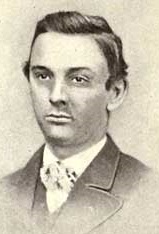
John Washington Steele
The petroleum drilling boom prompted by Edwin L. Drake’s discovery 15 years later — America’s first commercial oil well — would lead to the widow McClintock making a fortune in oil royalties. She left the money to Johnny when she died in 1864. At age 20, he inherited $24,500 and $2,800 a day in royalties.
“Coal Oil Johnny” Steele earned his name in 1865 after such a legendary year of extravagance that the New York Times later reported: “In his day, Steele was the greatest spender the world had ever known…he threw away $3 million ($50 million in 2021 dollars) in less than a year.”
Learn more in Legend of “Coal Oil Johnny.“

December 10, 1955 – LIFE features Stella Dysart’s Uranium Well
Mrs. Stella Dysart spent decades fruitlessly searching for oil in New Mexico. Some questionable business dealings led to bankruptcy in the late 1930s, but in 1955, a radioactive uranium sample from one of her failed oil wells made her a very wealthy woman.
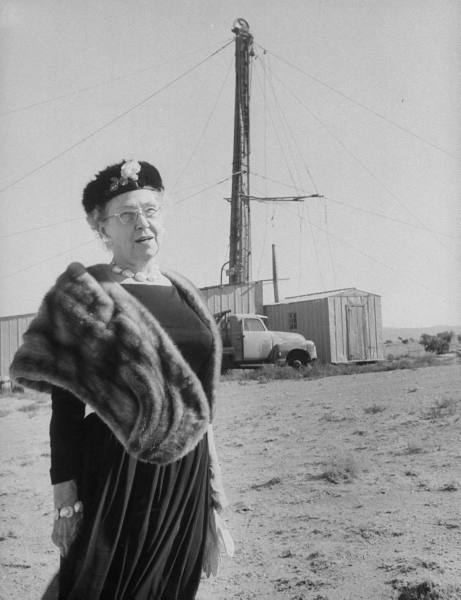
LIFE magazine featured Stella Dysart in December 1955.
Dysart was 78 years old when LIFE magazine featured her picture with the caption: “Wealthy landowner, Mrs. Stella Dysart, stands before an abandoned oil rig which she set up on her property in a long vain search for oil. Now uranium is being mined there and Mrs. Dysart, swathed in mink, gets a plump royalty.”
Just three years before the article, Dysart had been $25,000 in debt when cuttings from one of her “dusters” in McKinley County registered strong Geiger counter readings. Test wells confirmed that she owned the world’s richest deposit of high-grade uranium ore.
Learn more in Mrs. Dysart’s Uranium Well.
December 10, 1967 – Project Gasbuggy tests Nuclear Fracturing
Government scientists detonated a 29-kiloton nuclear warhead in a natural gas well about 60 miles east of Farmington, New Mexico. It was “fracking” late 1960s style, designed to test the feasibility of using nuclear explosions to stimulate release of gas trapped in shale deposits.
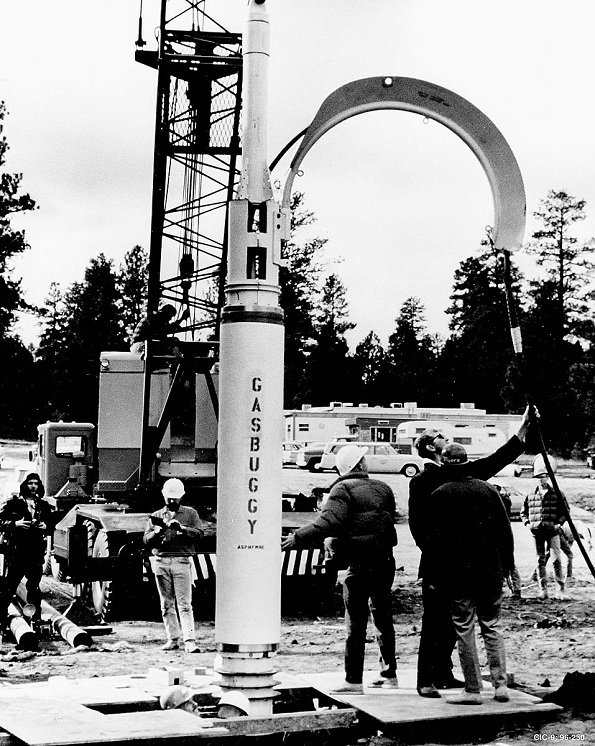
Scientists in December 1967 lowered a 29-kiloton nuclear device into a New Mexico gas well. Photo courtesy Department of Energy.
Project Gasbuggy included experts from the Atomic Energy Commission, the Bureau of Mines, and El Paso Natural Gas Company. Near three low-production natural gas wells, the team drilled to a depth of 4,240 feet and lowered a 13-foot by 18-inch diameter nuclear device into the borehole.
The experimental explosion was part a series of federal projects known as “Plowshare,” created in the late 1950s to explore peaceful uses of nuclear devices. The Project Gasbuggy downhole detonation created a molten glass-lined cavern 160 feet wide and 333 feet tall that collapsed within seconds. The well produced 295 million cubic feet of natural gas, but the gas was radioactive and useless.
Learn more in Project Gasbuggy tests Nuclear “Fracking.”

December 11, 1950 – Federal Offshore grows beyond Cannon Shot
After decades of controversy and a 1947 U.S. Supreme Court decision, the federal government’s “paramount rights” offshore were established beyond a three nautical mile limit, an 18th century precedent based on the theoretical maximum range of a smooth-bore cannon. The nation’s highest court prohibited any further offshore development without federal approval. In 1954, the Bureau of Land Management held the first Outer Continental Shelf lease sale, earning the government almost $130 million.
Learn more in Offshore Petroleum History.
December 11, 1972 – First Geologist walks on Moon
Astronaut and geologist Harrison “Jack” Schmitt stepped on the moon, joining Apollo 17 mission commander Eugene Cernan. Lunar experiments included a surface gravimeter to measure buried geological structures near the landing site. Schmitt also returned with the largest lunar sample ever collected.
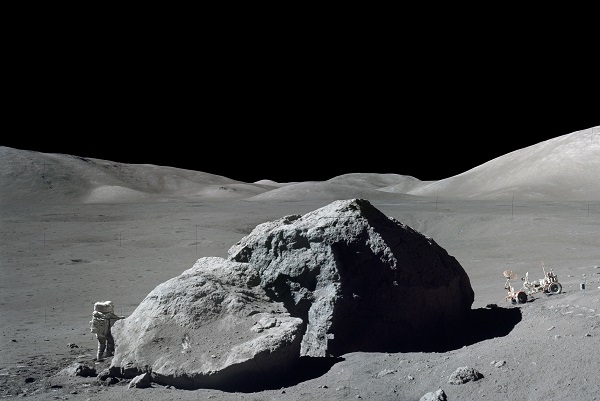
Geologist Harrison “Jack” Schmitt examined a boulder at the Apollo 17 Taurus-Littrow Valley lunar landing site in December 1972. Photo courtesy NASA.
Schmitt, who in 1964 received a PhD in geology from Harvard, was the first and last scientist on the moon, according to Cernan. When they left the Taurus-Littrow Valley landing site on December 14, 1972, he and the lunar geologist were the last of 12 men to walk on the moon. The 19th century petroleum product kerosene fueled all of the launches.
December 13, 1905 – Hybrids evolve with Gas Shortage Fears
“The available supply of gasoline, as is well known, is quite limited, and it behooves the farseeing men of the motor car industry to look for likely substitutes,” proclaimed the monthly journal Horseless Age.
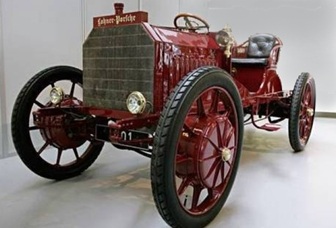
An early hybrid, this 1902 Porsche used a gas engine to generate electricity to power motors mounted on the front wheel hubs.
The magazine, first published in 1895, described early motor technologies, including the use of compressed air propulsion systems, electric cars, steam, and diesel power — as well as hybrids.
About the time of the first American auto show in November 1900, engineer Ferdinand Porsche introduced his gas-electric “Mixte” in Europe. The hybrid used a four-cylinder gasoline engine to generate electricity. The engine powered two three-horsepower electric motors mounted on the front wheel hubs. The car could achieve a top speed of 50 mph.
December 13, 1931 – Oilfield discovered in Conroe, Texas
Independent producer George Strake Sr. completed the South Texas Development Company No. 1 well eight miles southeast of Conroe, Texas, where he had leased 8,500 acres. By the end of 1932 the oilfield was producing more than 65,000 of barrels of oil a day. But disaster struck in the Conroe field in 1933 when derricks and equipment collapsed into a burning crater of oil. The fire would be put out thanks to relief wells drilled by George Failing and his newly patented truck-mounted drilling method (see Technology and the Conroe Crater).

December 13, 1985 – Route 66 decertified
Route 66, the “Mother Road” of modern highways since 1926, was decertified by the American Association of State Highway and Transportation Officials (AASHTO), which also voted to remove all Route 66 signs. Once stretching more than 2,400 miles from Illinois to California, the historic route was trailblazed in 1857 by a War Department expedition that included camels as pack animals.
By World War II, automobiles and trucks on the iconic roadway “helped to facilitate the single greatest wartime mobilization of labor in the history of the nation,” according to the National Park Service (NPS). By 1985, Route 66’s narrow asphalt paving and antiquated structure had been bypassed by the interstate system.
Learn more U.S. transportation history in America on the Move.
December 14, 1981 – Dowsing No Help in finding Minnesota Oil
Seeking oil investors, a Minnesota promoter proclaimed that dowsing with copper wires had located petroleum deposits in Nobles County, according to the Minneapolis Tribune, which reported the promoter had hired, “a Texas oilman and evangelist to lead a prayerful search for oil.” Despite no geological evidence, local investors paid $175,000 to drill a well that found no indication of oil or natural gas after reaching a depth of 1,500 feet.
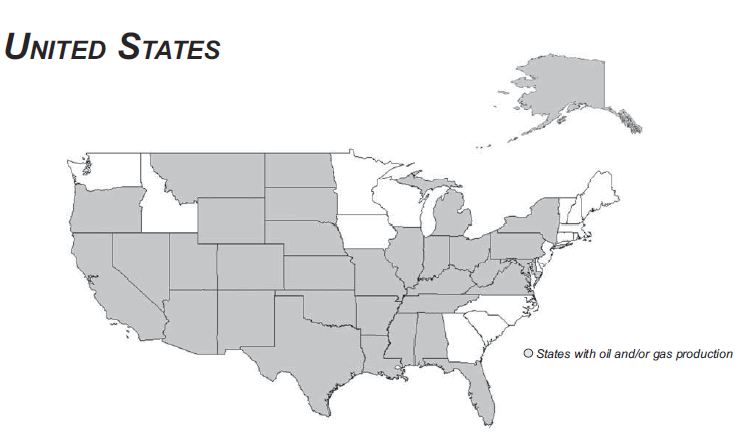
Minnesota is one of 17 states without any oil or natural gas production, according to the Independent Petroleum Association of America.
The Minnesota Geological Survey had reported in 1980 that of the state’s 17 exploratory wells drilled, “in suitable geologic settings,” none discovered commercial quantities of oil. The survey concluded, “the geologic conditions for significant deposits of oil and gas do not exist in Minnesota.”
_______________________
Recommended Reading: Fill’er Up!: The Great American Gas Station (2013); A History of the Greater Seminole Oil Field (1981); The Legend of Coal Oil Johnny
(2013); A History of the Greater Seminole Oil Field (1981); The Legend of Coal Oil Johnny (2007); Project Plowshare: The Peaceful Use of Nuclear Explosives in Cold War America
(2007); Project Plowshare: The Peaceful Use of Nuclear Explosives in Cold War America (2012); Stella Dysart of Ambrosia Lake: Courage, Fortitude and Uranium in New Mexico
(2012); Stella Dysart of Ambrosia Lake: Courage, Fortitude and Uranium in New Mexico (1959);
(1959);  Apollo and America’s Moon Landing Program: Apollo 17 Technical Crew Debriefing
Apollo and America’s Moon Landing Program: Apollo 17 Technical Crew Debriefing (2017); Electric and Hybrid Cars: A History
(2017); Electric and Hybrid Cars: A History (2010); Down the Asphalt Path: The Automobile and the American City
(2010); Down the Asphalt Path: The Automobile and the American City (1994).
(1994).
_______________________
The American Oil & Gas Historical Society (AOGHS) preserves U.S. petroleum history. Please become an AOGHS annual supporter and help maintain this energy education website and expand historical research. For more information, contact bawells@aoghs.org. Copyright © 2024 Bruce A. Wells. All rights reserved.
by Bruce Wells | Dec 2, 2024 | This Week in Petroleum History
December 2, 1942 – Roosevelt creates Petroleum Administration for War –
President Franklin D. Roosevelt established the Petroleum Administration for War, “for the successful prosecution of the war and other essential purposes.” The executive order came after oil and natural gas industry leaders met with Interior Secretary Harold L. Ickes, head of the newly created Office of Petroleum Coordinator for National Defense, which established five districts for managing gasoline rationing. (more…)
by Bruce Wells | Nov 25, 2024 | This Week in Petroleum History
November 25, 1875 – Continental Oil sends Kerosene Westward –
Convinced he could profit by purchasing bulk kerosene in cheaper eastern markets, Isaac Blake formed the Continental Oil and Transportation Company and began transporting kerosene refined in Cleveland, Ohio, for distribution in Ogden, Utah. (more…)
by Bruce Wells | Nov 18, 2024 | This Week in Petroleum History
November 18, 1847 — Manufactured Gas illuminates U.S. Capitol –
Lamps fueled by “coal gas” began replacing whale oil lamps in the U.S. Capitol. Manufactured gas distilled beneath the Capitol flowed through newly installed pipes into light fixtures, including chandeliers in both House chambers. James Crutchett had invented the lighting system and convinced Congress to appropriate $17,500 to fund his plan, which included a lantern atop the dome.
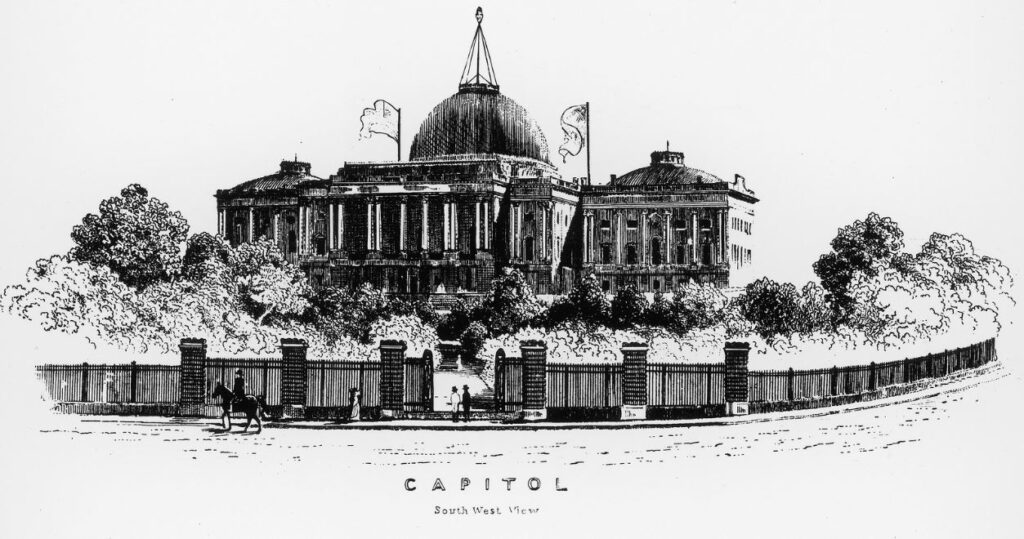
A mast with gas lantern was erected on the U.S. Capitol dome in 1847. By 1865, the rotunda interior used 1,083 gas jets. Incandescent lighting began in 1885. Image courtesy Architect of the Capitol.
Onlookers witnessed, “one of the most splendid and beautiful spectacles we ever beheld,” according to David Rotenstein in History Sidebar. Crutchett built a gas plant in the Capitol’s northwest quadrant, placing lighting fixtures throughout the building.
Although the dome’s 80-foot mast and lantern would be removed within a year, a citywide manufactured gas system followed — similar to ones established in Philadelphia and Baltimore (see Illuminating Gaslight).

November 19, 1861 – America exports Oil for First Time
America exported petroleum for the first time when the merchant brig Elizabeth Watts departed the Port of Philadelphia for Great Britain. The Union vessel arrived in London 45 days later carrying a cargo of 901 barrels of Pennsylvania oil and 428 barrels of refined kerosene.
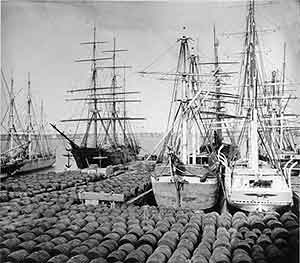
A merchant brig set sail from Philadelphia in 1861 with a cargo of Pennsylvania oil and refined kerosene. Photo of vinegar barrels at Massachusetts port in 1870, courtesy New Bedford Whaling Museum.
The shippers were the successful Philadelphia import-export firm of Peter Wright & Sons, which since its founding in 1818 had prospered transporting glass, porcelain and queensware china. The company hired the Elizabeth Watts to ship the petroleum to three British companies. On January 9, 1862, the brig sailed down the Thames River to arrive at London, where it took 12 days to unload the 1,329 barrels of oil and kerosene.
Learn more in America exports Oil.
November 19, 1927 – Phillips Petroleum introduces “Phillips 66” Gasoline
After a decade as an exploration and production company, Phillips Petroleum entered the business of refining and retail gasoline distribution. The Bartlesville, Oklahoma, company introduced a new line of gasoline — “Phillips 66” — at its first service station, which opened in Wichita, Kansas.
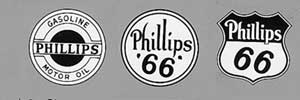
Originally promoted as a dependable “winter gasoline,” by 1930 “Phillips 66” gasoline was marketed in 12 states.
The gasoline was named “Phillips 66” because it had propelled company officials down U.S. Highway 66 at 66 mph on the way to a meeting at their Bartlesville headquarters. The roadway became part of Phillips Petroleum marketing plans for the new product, which boasted “controlled volatility,” the result of a higher-gravity mix of naphtha and gasoline.
By 1930, Phillips 66 gasoline was sold at 6,750 outlets in 12 states. Because the composition made Phillips 66 gas easier to start in cold weather, ads enticed motorists to try the “New Winter Gasoline.” Visit the Phillips Petroleum Company Museum, which opened in 2007.
November 20, 1866 – Improved Well Torpedo patented
Col. Edward A.L. Roberts of New York City patented improvements to his Roberts Torpedo, an oilfield technology for increasing production by fracturing oil-bearing formations. “Our attention has been called to a series of experiments that have been made in the wells of various localities by Col. Roberts, with his newly patented torpedo,” noted the Titusville Morning Herald newspaper in 1865. “The results have in many cases been astonishing.”
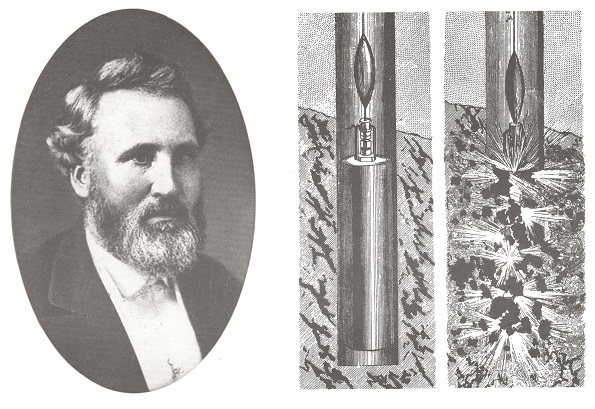
Portrait of Col. Edward Roberts, the Union Civil War veteran who patented well “torpedo” technologies that vastly improved oil production.
The Civil War Union Army veteran would receive many patents for his “Exploding Torpedoes in Artesian Wells” method to increase petroleum production (see Shooters – A “Fracking” History).
November 20, 1930 – Oil Booms bring Hilton Hotels to Texas
After buying his first hotel in the booming oil town of Cisco, Texas, Conrad Hilton opened a high-rise in El Paso. While visiting Cisco in 1919, Hilton had witnessed roughnecks from the Ranger oilfield waiting for rooms. Hilton’s first hotel, the Mobley, offered 40 rooms for eight-hour periods to coincide with workers’ shifts. Thanks to booming oilfields, Hilton was firmly established in Texas. His El Paso Hilton (now the Plaza Hotel) was placed on the National Register of Historic Places in 1980.

November 20, 1980 – Texaco Well drains Louisiana Lake
Minutes after its drilling crew evacuated, a Texaco drilling platform overturned and disappeared into a whirlpool that drained Lake Peigneur, Louisiana, over the next three hours. The crew had accidentally penetrated a salt dome containing the mining operations of Diamond Crystal Salt Company.
All 50 miners working as deep as 1,500 feet below the surface escaped with no serious injuries as a maelstrom swallowed the $5 million Texaco platform — and 11 barges holding drilling supplies.
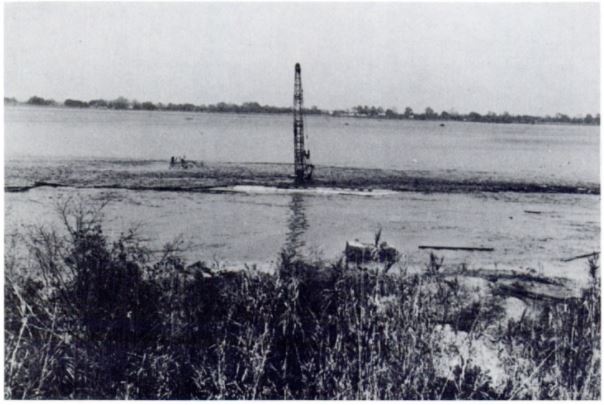
Photo from a 1981 government study of the “Jefferson Island Mine Inundation,” Texaco’s accidental drilling into a salt mine one year earlier. Photo courtesy Federal Mine Safety and Health Investigation Report.
“Texaco, who had ordered the oil probe, was aware of the salt mine’s presence and had planned accordingly; but somewhere a miscalculation had been made, which placed the drill site directly above one of the salt mine’s 80-foot-high, 50-foot-wide upper shafts,” noted a 2005 article about the Lake Peigneur vortex.
According to a 1981 government report, “Jefferson Island Mine Inundation,“ evidence for identifying the exact cause was washed away, but Texaco and Wilson Drilling paid $32 million to Diamond Crystal Salt Company and another $12.8 million to a nearby botanical garden. Changed from freshwater to saltwater with a depth reaching 200 feet, Lake Peigneur became the deepest lake in Louisiana.
November 21, 1925 – Magnolia Petroleum incorporates
Formerly an unincorporated joint-stock association with roots dating to an 1889 refinery in Corsicana, Texas, Magnolia Petroleum Company incorporated. The original association had sold many grades of refined petroleum products through more than 500 service stations in Texas, Oklahoma, and Arkansas.
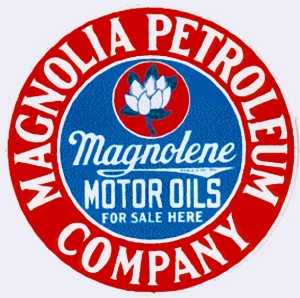
Magnolia Petroleum operated gas stations throughout the Southeast.
Within a month of the new company’s founding, John D. Rockefeller’s Standard Oil of New York (Socony) purchased most Magnolia Petroleum assets and operated it as a subsidiary. Magnolia merged with the Socony Mobile Oil Company in 1959 and adopted the red Pegasus logo at gas stations. Magnolia Petroleum assets were part of the 1999 merger that created ExxonMobil.
Learn more in Mobil’s High-Flying Trademark.

November 21, 1980 – Millions watch “Dallas” Episode
The cliffhanger episode “Who shot J.R.?” on the prime-time soap opera “Dallas” was watched by 83 million people in the United States and 350 million worldwide. The CBS show debuted in 1978 and revolved around two Texas oil families, one featuring Larry Hagman as J.R. Ewing, “the character fans loved to hate,” according to History.com. Hagman’s portrayal of a “greedy, conniving, womanizing scoundrel” and the business dealings of Ewing Oil Company would stereotype the Texas petroleum industry for seasons.
November 22, 1878 – Tidewater Pipe Company established
Byron Benson organized the Tidewater Pipe Company in Pennsylvania. In 1879 his company would build the first oil pipeline to cross the Alleghenies from Coryville to the Philadelphia Reading Railroad 109 miles away in Williamsport. This technological achievement was considered by many as the first true oil pipeline in America, if not the world.
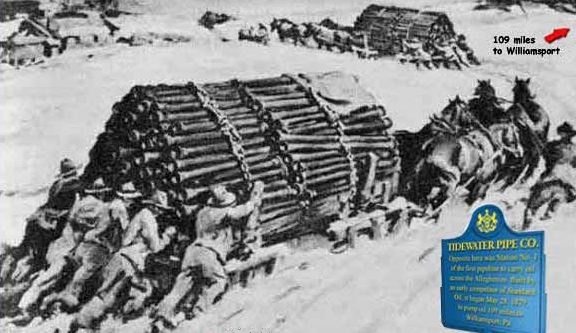
Despite protests from teamsters, a 109-mile oil pipeline revolutionized oil transportation. Photo courtesy explorepahistory.com.
The difficult work — much of it done in winter using sleds to move pipe sections — bypassed Standard Oil Company’s dominance in transporting petroleum. Tidewater made an arrangement with Reading Railroad to haul the oil in tank cars to Philadelphia and New York. In 1879, about 250 barrels of oil from the Bradford field was pumped across the mountains and into Williamsport.
More than 80 percent of America’s oil soon would come from Pennsylvania oilfields, according to Floyd Hartman Jr. in a 2009 article, “Birth of Coryville’s Tidewater Pipe Line.”
November 22, 1905 – Glenn Pool Field discovered in Indian Territory
Two years before Oklahoma statehood, the Glenn Pool (or Glenpool) oilfield was discovered in the Creek Indian Reservation south of Tulsa. The greatest oilfield in America at the time, it would help make Tulsa the “Oil Capital of the World.” Many independent oil producers, including Harry F. Sinclair and J. Paul Getty, got their start during the Glenn Pool boom.
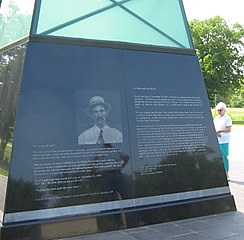
An oilfield pioneers monument was dedicated in April 2008 at Glenpool, Oklahoma. Photo by Bruce Wells.
With production exceeding 120,000 barrels of oil a day, Glenn Pool exceeded Tulsa County’s earlier Red Fork Gusher. The giant oilfield even exceeded production from Spindletop Hill in Texas four years earlier. The Ida Glenn No. 1 well, drilled to about 1,500 feet deep, led to more prolific wells in the 12-square-mile Glenn Pool.
By the time of statehood in 1907, Tulsa area oilfields made Oklahoma the biggest U.S. oil-producing state. Learn more in Making Tulsa “Oil Capital of the World.”

November 22, 2003 – Smithsonian Museum features Transportation
A permanent exhibit about U.S. transportation history opened at the Smithsonian’s National Museum of American History in Washington, D.C. “Get your kicks on 40 feet of Route 66,” the Smithsonian exhibit noted on opening day of the $22 million renovation of the museum’s Hall of Transportation.
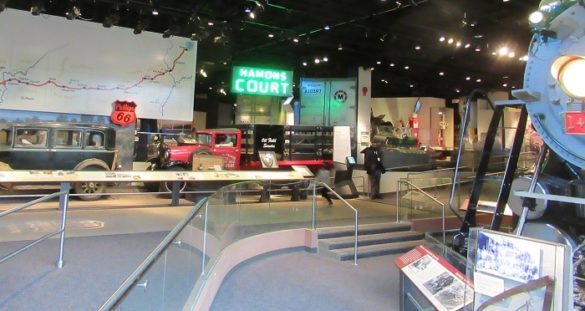
Opened in 2003 after a $22 million renovation, the Transportation Hall of the National Museum of American History exhibits 340 historic objects in 26,000 square feet. Photo by Bruce Wells.
Hundreds of artifacts are displayed in chronological order, allowing visitors “travel back in time and experience transportation as it changed America,” the hall today includes examples of the first models of Oldsmobile, Franklin, and Cadillac. Also preserved is the Duryea brothers’ 1893-1994 model considered to be the first American car driven by an internal combustion engine.
Learn more in America on the Move.

November 23, 1947 – World’s First LPG Ship
The first U.S. seagoing Liquefied Petroleum Gas (LPG) ship went into service as Warren Petroleum Corporation of Tulsa, Oklahoma, sent the Natalie O. Warren from the Houston Ship Channel to Newark, New Jersey. The vessel had an LPG capacity of 38,053 barrels in 68 vertical pressure tanks.

The Natalie O. Warren, a converted freighter, had an LPG capacity of 38,053 barrels in 68 vertical pressure tanks.
The one-of-a-kind ship was the former Cape Diamond dry-cargo freighter before being converted by the Bethlehem Steelyard in Beaumont, Texas. The experimental design led to innovative maritime construction standards for such vessels.
Warren Petroleum became the largest producer and marketer of natural gasoline and propane in the world by the early 1950s, according to an exhibit at the Tulsa Historical Society and Museum. LPG tankers today carry 20 times the capacity of the early vessels.
_______________________
Recommended Reading: The Extraction State, A History of Natural Gas in America (2021); Oil Man: The Story of Frank Phillips and the Birth of Phillips Petroleum (2016); History Of Oil Well Drilling
(2016); History Of Oil Well Drilling (2007); Be My Guest
(2007); Be My Guest (1957); Magnolia Oil News Magazine
(1957); Magnolia Oil News Magazine (January 1930); Oil and Gas Pipeline Fundamentals
(January 1930); Oil and Gas Pipeline Fundamentals (1993); Glenn Pool…and a little oil town of yesteryear
(1993); Glenn Pool…and a little oil town of yesteryear (1978); The American Highway: The History and Culture of Roads in the United States
(1978); The American Highway: The History and Culture of Roads in the United States (2000); CONOCO: The First One Hundred Years Building on the Past for the Future
(2000); CONOCO: The First One Hundred Years Building on the Past for the Future (1975); Natural Gas: Fuel for the 21st Century
(1975); Natural Gas: Fuel for the 21st Century (2015). Your Amazon purchase benefits the American Oil & Gas Historical Society. As an Amazon Associate, AOGHS earns a commission from qualifying purchases.
(2015). Your Amazon purchase benefits the American Oil & Gas Historical Society. As an Amazon Associate, AOGHS earns a commission from qualifying purchases.
_______________________
he American Oil & Gas Historical Society (AOGHS) preserves U.S. petroleum history. Please become an AOGHS annual supporter and help maintain this energy education website and expand historical research. For more information, contact bawells@aoghs.org. Copyright © 2024 Bruce A. Wells. All rights reserved.
by Bruce Wells | Nov 11, 2024 | This Week in Petroleum History
November 11, 1884 – Gas Companies merge into Con Edison –
The largest U.S. gas utility company at the time was created in New York City when six gas-light companies — using manufactured coal gas — combined to form the Consolidated Gas Company. The Consolidated Edison Company, “Con Ed,” began six decades earlier as the New York Gas Light Company, which received a charter from the state legislature in 1823.
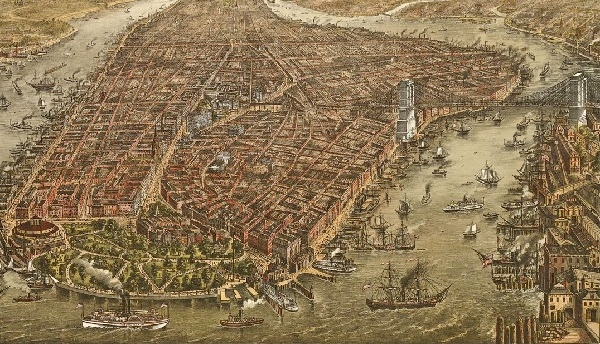
“Bird’s-eye view” illustrates New York and Brooklyn in 1873. The Brooklyn Bridge, then under construction, can be seen at the right. Image courtesy Library of Congress.
Like most early manufactured gas companies, New York Gas Light focused early efforts on public street lighting (see Illuminating Gaslight), replacing whale oil lamps installed by the city beginning in the 1760s.
Prior to the 1884 merger of the competing companies, streets often were being torn up by competing workmen installing or repairing their own company’s lines — and removing those of a rival. “Sometimes these work crews would meet on the same street and brawl, giving rise to the term “gas house gangs.”
Learn more in History of Con Edison.

November 11, 1926 – Route 66 officially commissioned
Five years after the Federal Aid Highway Act of 1921, U.S. Highway 66 was commissioned as a major thoroughfare in the national highway system. America’s “Mother Road” from Chicago to Los Angeles connected rural and urban communities along its almost 2,500 miles — until the interstate system incrementally replaced it.
Extended from Los Angeles to Santa Monica in 1935, Route 66 lost its highway status 50 years later when the American Association of State Highway and Transportation Officials officially decertified it. In 2019, Oklahoma established the Route 66 Centennial Commission, assisted by the Oklahoma Historical Society, to plan events celebrating the historic highway’s centennial in 2026.
November 12, 1899 – New York World features Mrs. Alford and her Nitro Factory
An 1899 article in the New York World profiled Mrs. Byron Alford — the “Only Woman in the World who Owns and Operates a Dynamite Factory.”
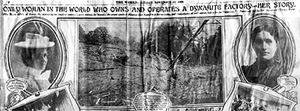
A laminated (though wrinkled) newspaper page from 1899 was part of a school project of a Mrs. Alford descendant, according to the Penn-Brad Oil Well Park and Museum in Bradford, Pennsylvania.
Mrs. Alford’s dangerous business operated on five acres outside of Bradford, Pennsylvania, with a daily production of 3,000 pounds of nitroglycerin and 6,000 pounds of dynamite. Local drillers used the explosives for “shooting” wells to boost production.
The article noted “the astute businesswoman” manufactured her volatile mixtures in 12 separate buildings, all made of wood and unpainted.
Learn more in Mrs. Alford’s Nitro Factory.
November 12, 1916 – Forest Oil Company formed
Forest Oil Company incorporated and began operations in the Bradford oilfield of northern Pennsylvania. The company, after adopting a “yellow dog” lantern logo, launched an important new technology: water-flooding (injecting water into oil-bearing formations) to stimulate production from depleted wells.
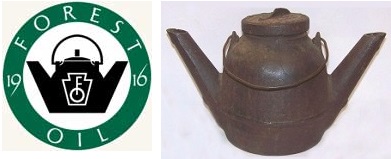
Forest Oil’s “yellow dog” lantern logo beside the oilfield lantern.
Water-flooding technology for enhanced recovery spread throughout the petroleum industry – and extended many wells’ lives by as much as a decade.
After merging in 1924 with four independent oil companies (January Oil Company, Brown Seal Oil, Andrews Petroleum, and Boyd Oil), Forest Oil was headquartered in Denver before being acquired in 2014 by a privately held Houston company.
November 12, 1999 – Plastics designated Historic Landmark
The American Chemical Society designated the discovery of a high-density polyethylene process as a National Historic Chemical Landmark in a ceremony at the Phillips Petroleum Company in Bartlesville, Oklahoma. The oil company had entered the plastics business in 1951 after discovering a catalyst for creating solid polymers.
“The plastics that resulted — crystalline polypropylene and high-density polyethylene (HDPE) — are now the core of a multibillion-dollar, global industry,” the society noted. Among the first customers for Phillips Petroleum plastics was Wham-O, which used it to make Hula Hoops and Frisbees in the 1950s.

November 13, 1943 – Death during Secret WWII Drilling Project
Derrickhand Herman Douthit of Caddo Mills, Texas, died from a fall at Well Number 148 in England’s Sherwood Forest, where he was part of a top-secret group of Americans drilling to expand production from the Eakring field. The roughnecks of Sherwood Forest increased production faster than their British counterparts while working 12-hour shifts in four crews. “Rigs shut down for one shift for his funeral, then back to work,” recalled Lewis Dugger of Louisiana. Forty-one of the volunteers returned safely in March 1944. Douthit was buried near Cambridge with full military honors.
November 14, 1927 – Gasometer Explosion shakes Pittsburgh
Three natural gas containers — gasometers — exploded in Pittsburgh, producing “tremors such as might have been caused by a severe earthquake,” according to a 1927 report, which noted the deaths of 28 people and injury of more than 400.
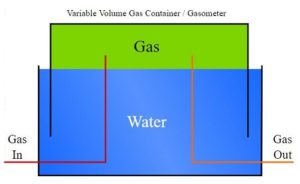
More often found in Europe, gasometers were replaced by high-pressure vessels for liquefied natural gas.
First used in the late 19th century for manufactured gas (and throughout the 20th century for natural gas), gasometers were large, cylindrical containers for storing gas at near atmospheric pressure at ambient temperatures. The volume of stored gas varied, with pressure added from the weight of a movable cap.
According to a 2006 Pittsburgh Magazine article, workmen had been using acetylene torches to repair a leak on top of a tank with a capacity of 5 million cubic feet of gas. Gasometers structures have been replaced by high-pressure vessels to store natural gas in liquid form (learn more in Horace Horton’s Spheres).
November 14, 1947 – First Oil Well drilled Out of Sight of Land
The modern offshore oil and natural gas industry began in the Gulf of Mexico with the first oil well successfully completed out of sight of land. Brown & Root Company built the experimental freestanding platform 10 miles offshore for Kerr-McGee and partners Phillips Petroleum and Stanolind. The platform, Kermac 16, was designed to withstand winds as high as 125 miles per hour.
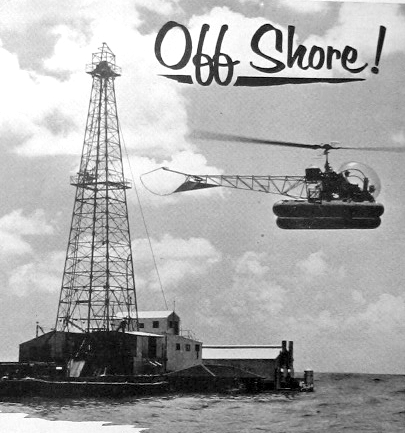
The Kermac 16 platform was featured in a 1954 Bell Helicopter advertisement encouraging use of helicopters for offshore transportation.
After investing $450,000, Kerr-McGee completed the well in about 20 feet of water off Louisiana’s gradually sloping Gulf coast. The Kermac No. 16 well initially produced 40 barrels of oil per hour.
Kerr-McGee had purchased World War II surplus utility freighters and materials to provide supplies, equipment, and crew quarters for the drilling site at Ship Shoal Block 32. Sixteen 24-inch pilings were sunk 104 feet into the ocean floor to secure a 2,700-square-foot wooden deck. The Kermac No. 16 platform withstood several 1947 hurricanes and tropical storms.
Learn more about offshore technologies in Offshore Drilling History.
November 14, 1947 – WW II “Big Inch” and “Little Big Inch” Pipelines Sold
Texas Eastern Transmission Corporation, a company established 11 months earlier to acquire the World War II surplus 24-inch “Big Inch” and 20-inch “Little Big Inch” pipelines, won ownership of them with a bid of $143,127,000. It was America’s largest sale of war surplus material to the private sector.
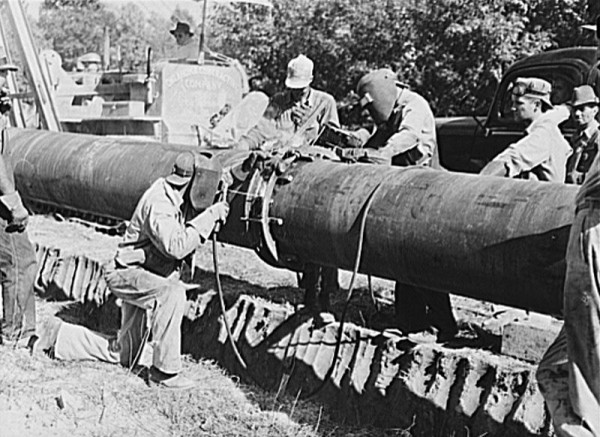
War Emergency Pipelines, Inc., in 1942 began construction of the longest U.S. petroleum pipeline construction ever undertaken in the United States — two pipelines spanning 1,200 miles. Photo Courtesy Library of Congress.
By the 1950s, Texas Eastern Transmission converted both oil product pipelines to natural gas, which was needed for the Appalachian region. By the 2000s, transmission would become bi-directional for carrying natural gas from the Marcellus and Utica shale to mid-west markets. The Big Inch Pipelines of WW II were added to the National Register of Historic Places in 1998.
November 15, 1906 – Justice Department seeks Breakup of Standard Oil
U.S. Attorney General Charles Bonaparte filed suit to compel dissolution of Standard Oil of New Jersey. Despite an 1892 court decision ordering the Standard Oil Trust to be dissolved, John D. Rockefeller reorganized it and continued to operate from New York. The Justice Department won the latest suit and Standard Oil appealed to the U.S. Supreme Court, which affirmed the lower court’s decision on May 15, 1911, and mandated dissolution of Standard Oil into 34 separate companies.

November 15, 1952 – Williston Basin produces Millionth Barrel of Oil
The Williston Basin produced its millionth barrel of oil, which came from five fields in three counties in North Dakota, where Amerada Petroleum had launched a 1951 drilling boom northeast of Williston (see First North Dakota Oil Well). By the end of 1952, the Williston Basin’s production reached 356,000 barrels of oil a month.
by Bruce Wells | Nov 4, 2024 | This Week in Petroleum History
November 6, 1860 – First Multi-Still Oil Refinery started in Pennsylvania –
As the Civil War neared, construction began on America’s first multiple-still oil refinery. William Barnsdall, who completed a oil well soon after the first U.S. oil well of August 1859, spent $15,000 to build six stills for refining kerosene one mile south of Titusville, Pennsylvania. (more…)






(2013); A History of the Greater Seminole Oil Field (1981); The Legend of Coal Oil Johnny
(2007); Project Plowshare: The Peaceful Use of Nuclear Explosives in Cold War America
(2012); Stella Dysart of Ambrosia Lake: Courage, Fortitude and Uranium in New Mexico
(1959);
Apollo and America’s Moon Landing Program: Apollo 17 Technical Crew Debriefing
(2017); Electric and Hybrid Cars: A History
(2010); Down the Asphalt Path: The Automobile and the American City
(1994).




















